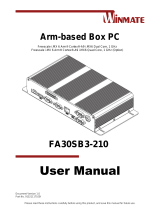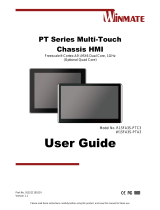
ARMPAC-6XX Series User Manual
Table of Contents
Revision History…………………………………………………………………………………………………….1
Warning!.............................................................…………………………….……………………2
Caution/Disclaimer………………….......………………………………………………………………………3
Packing List…………………………………….…………………………………………………....................4
Safety Precautions………………………………….……………….…..……………………....................5
Chapter 1 Getting Started
1.1 Features……..…………………..………………………...…………………………..6
1.2 Specifications…..………………...………………………………………………….6
1.3 Dimensions……..…………………....……………………………………………...8
1.4 Brief Description of ARMPAC-6XX…..….…..……………………….……10
1.5 VESA Mounting……………….…………..………..…...…………………..…..11
1.6 Panel Mounting…..………….…………..………..…...…………………..…..11
Chapter 2 Hardware
2.1 Motherboard Jumpers Setting and Connectors…………………...12
Chapter 3 Software images
3.1 Update Linux for SBC-7112……….....................……………………...18
3.2 Update Android Firmware….………..................……………………...21
Figures
Figure 1.1: Dimensions of ARMPAC-607(P)..…….……….……………………….…..8
Figure 1.2: Dimensions of ARMPAC-608(P)………………… ……..………………….8
Figure 1.3: Dimensions of ARMPAC-610(P) ……………………………………..…….9
Figure 1.4: Dimensions of ARMPAC-612(P)…..……..…………………………………9
Figure 1.5: Front View of ARMPAC-6XX Series………………………………………10
Figure 1.6: Rear View of ARMPAC-6XX Series…………………………………….…10
Figure 1.7: ARMPAC-6XX Series VESA Mounting.……..……………….……….…11
Figure 1.8: ARMPAC-6XX Series Panel Mounting…..…………………………..11
























